- Sustainability
- DE&I
- Pandemic
- Finance
- Legal
- Technology
- Regulatory
- Global
- Pricing
- Strategy
- R&D/Clinical Trials
- Opinion
- Executive Roundtable
- Sales & Marketing
- Executive Profiles
- Leadership
- Market Access
- Patient Engagement
- Supply Chain
- Industry Trends
2023 Pharm Exec Top 50 Companies
With the sales boom from COVID-19 products now in the rear-view, a resetting is underway for those in Pharm Exec’s listing of the top biopharma producers—shifting attention to new Rx roads ahead and the steady strategies needed to navigate a bumpy business terrain.
Source: FrankBoston/stock.adobe.com
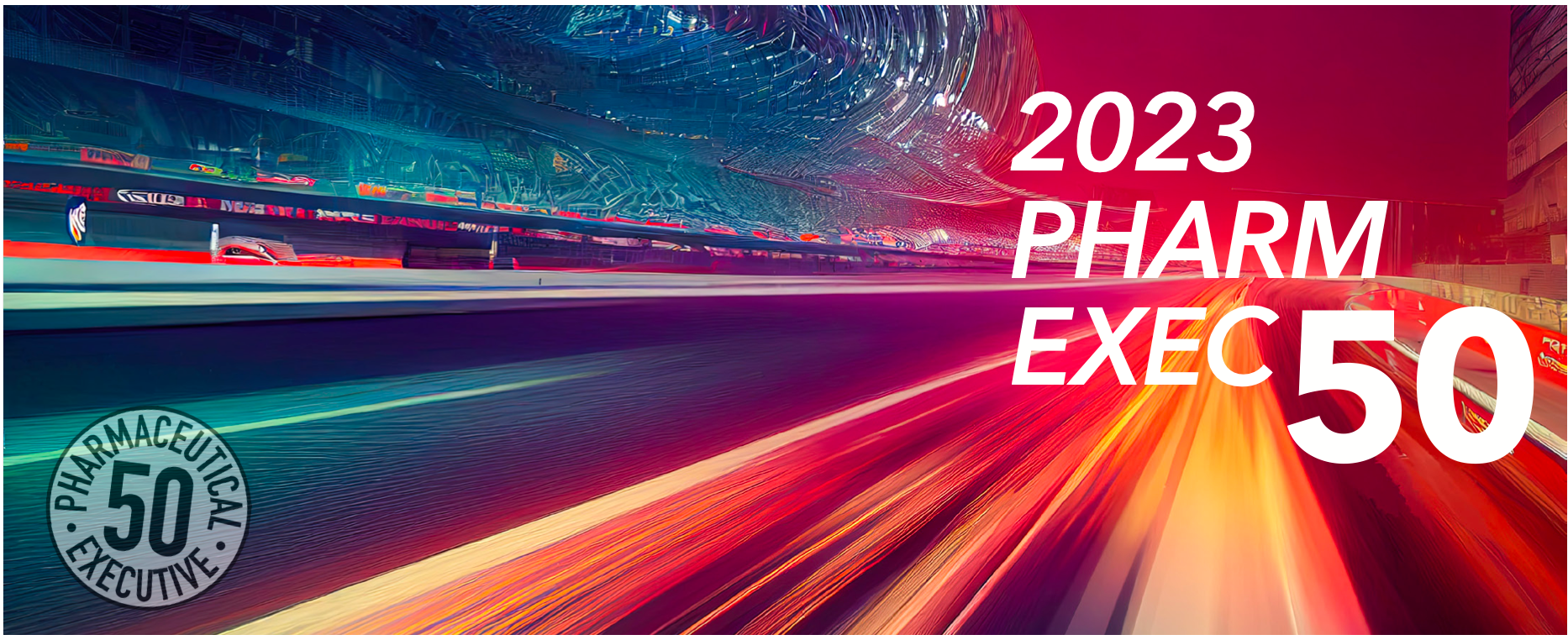
This year’s rankings of the top 50 global biopharma players based on prescription drug sales, our 23rd such installment, paints two distinctly different pictures concerning the trajectory of the industry’s commercial output and product direction. One is readily apparent, as the numbers reflect—capturing most recent full-year drug revenue performance (in this case, 2022)—and the tipping point or subsequent decent down the COVID-19 product cliff. The other, when peeking beneath the data, foretells a recalibration of sorts that seems to be materializing, with non-pandemic treatment trends, market drivers, and macroeconomic and geopolitical factors once again taking center stage in driving future fortunes—and potential risers and other compelling shuffling to our list in the years ahead.
It’s the second story, of course, that is still being written—and predicting pharma narratives is never easy. But one thing appears certain: By the end of the decade, the complexion of our Pharm Exec 50 will likely appear vastly different. The data for this year’s list was again provided in partnership with Evaluate Ltd. It also includes each company’s top-selling drugs and R&D investment totals.
“It will be the ones around the bottom that might drop out of the top 10. And you’ll see others—like Novo [Nordisk] and [Eli] Lilly—come in, I think,” Amy Brown, special reports and projects editor, Evaluate Vantage, tells Pharm Exec. Brown cites those two companies in particular due to their looming battle for market share in the lucrative GLP-1 receptor agonist space set to explode in weight loss (Evaluate projects the global obesity market to reach close to $50 billion by 2028, with a compound annual growth rate of 36% until then). Other advancing treatment settings of note that could rearrange the Pharma 50 deck in the years ahead—though some likely faster than others—include respiratory syncytial virus (RSV) vaccines (the first ones, made by GSK and Pfizer, were approved recently for older adults); Alzheimer’s disease (its drug market is forecast by GlobalData to hit $13.7 billion across the eight major markets: US, France, Germany, Italy, Spain, UK, Japan, and China by 2030); new antibody-drug conjugates (ADCs) for cancer that may address limitations for some patients who have taken PD-1 and PD-L1 inhibitors, a top-selling drug class; as well as potentially more effective options in chronic obstructive pulmonary disease (COPD), geographic atrophy (GA), and chronic inflammatory demyelinating polyneuropathy.
These evolving markets, and the developers involved, of course, are not immune to current business pressures and the wider inflation and supply chain climates impacting the industry. But perhaps, as some in Big Pharma’s medium-sized contingent seek to ascend upward and join their larger peers, and a few smaller players in our list seize opportunities to enter the middle territory, it will be those companies that have a leg up. That may be particularly true given recent high-profile developments in M&A pursuits and other seemingly daily news reports of the tough operational choices many—large and small firms alike—have been forced to make. These have ranged from layoffs to pipeline and business unit cuts to “restrategizing” efforts.
On the M&A front, the decision by the US Federal Trade Commission (FTC) in May to file a lawsuit blocking the anticipated $27.8 billion acquisition of Horizon Therapeutics by Amgen (first announced in December 2022) has shook up the dealmaking landscape—one that has rebounded considerably so far in 2023 after significant slowdowns the last couple years.
“[With that news], everyone is a bit nervous about making big acquisitions,” says Brown. “You might see more deals between the mid-range companies. Perhaps those would be less concerning from a competition point of view. And you’re kind of creating more competition for the top tier then, aren’t you?”
Those top-tier players—several with popular and expensive branded treatments—also face the specter of Medicare price negotiations in the US as the Inflation Reduction Act, passed last August, begins to be implemented in the next few years. Organizations, including the likes of Pfizer (who leads our Pharma 50 list again by a wide margin and has its own pending mega deal with oncology power Seagen in the works), Roche, GSK, Merck and Co., and Bristol Myers Squibb (BMS), are all under particular pressure to navigate these waters, each seeking to jumpstart respective pipelines and lessen the sting of key near and long-term patent expirations that threaten future earnings.
Impacts from M&A, COVID
Biopharma M&A dollar volume, according to investment banking company Stifel, could reach $208 billion by the end of the year. It’s safe to wonder if such expectations will bear out. The FTC argues that the Amgen-Horizon deal would “stifle competition.” Amgen, ranked 15th in the latest Pharma 50 ledger, down one spot and 5.9% in sales from full-year 2021, would add two fast-growing drugs from Horizon’s stable—Tepezza for thyroid eye disease and Krystexxa for chronic refractory gout. The pair combined for almost $2.7 billion in sales in 2022, helping catapult Dublin-based Horizon into our top 50 for the first time at No. 42 on this year’s list. What may offer pause for other Big Pharma hunting for large acquisitions and new assets is the fact that Amgen’s top five drugs all focus on different areas and do not overlap the Horizon tandem. FTC contends, however, that the deal would give Amgen greater freedom to use rebates on its existing medicines to influence pricing and pressure payers into favoring Tepezza and Krystexxa, which are already monopoly products. Nevertheless, the deal reportedly could still close in the fourth quarter if the FTC’s challenge fails (as of press time, there was no decision yet on the lawsuit).
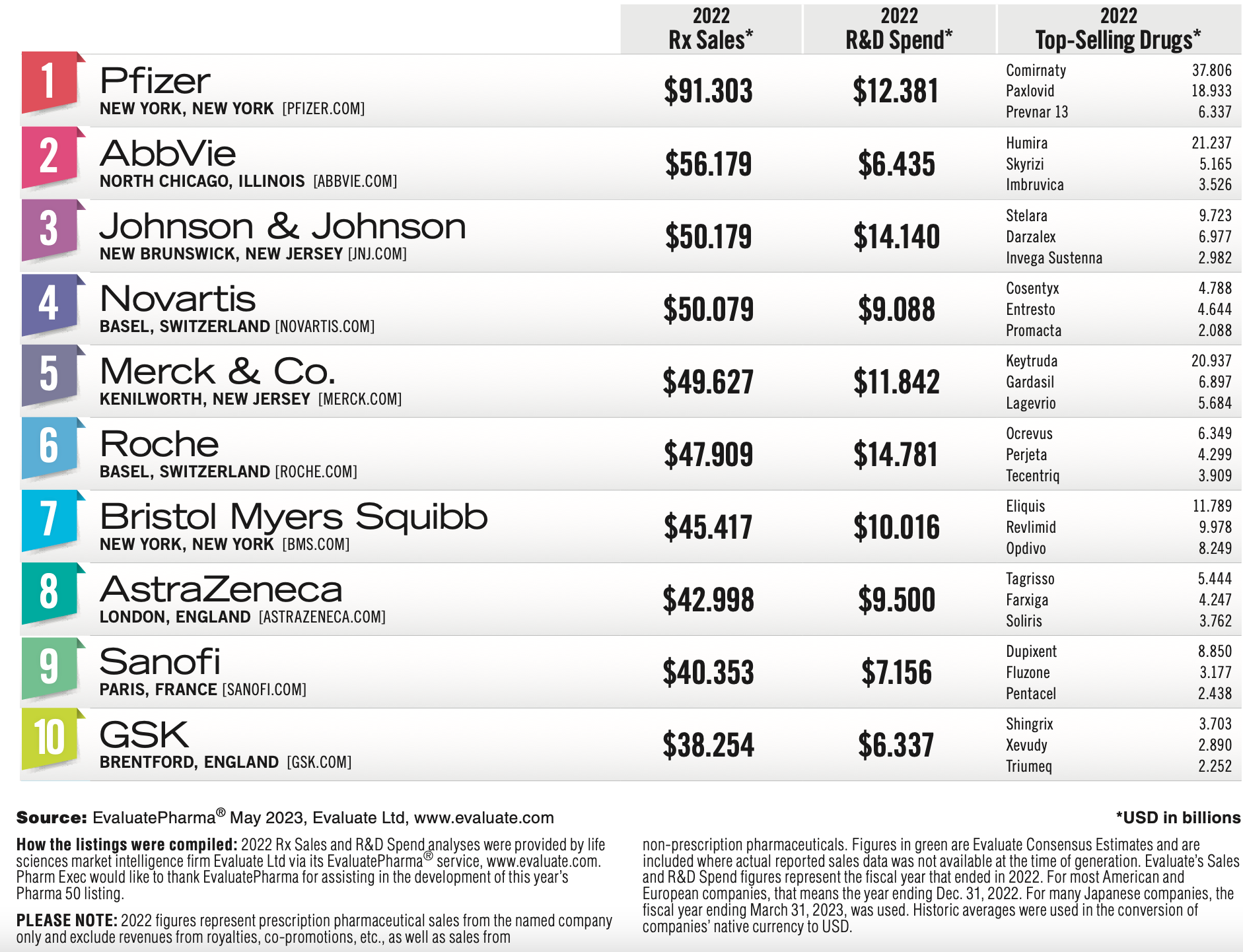
Experts are wary of potential aftershocks for Pfizer’s proposed $43 billion Seagen acquisition. Pfizer has enjoyed incredible growth over the last two years on the strength and success of its COVID mRNA vaccine, Comirnaty, made in partnership with BioNTech, and its COVID antiviral therapy, Paxlovid. Following a 102% increase in Rx sales from 2020-2021, Pfizer prescription drug revenue made a second big leap, rising 26.7% in 2022 to $91.3 billion. Comirnaty increased 2.6% to $37.8 billion, while Paxlovid, in its first year, brought in $18.9 billion, nearing the rarified air of AbbVie’s Humira (which posted its largest yearly output ever in 2022 at $21.2 billion) and Merck’s Keytruda ($20.9 billion) as the highest grossing non-vaccines to date.
Capitalizing as well was German-based BioNTech, which crept its way into the top 50 this year, at No. 47, thanks to its $3.4 billion share of Comirnaty. Interestingly, Maryland-based Novavax also appears in our Pharma 50, grabbing the last slot, having generated $1.6 billion in revenue for its protein-based COVID vaccine, Nuvaxovid. It was Moderna who was welcomed into our list a year ago but with more gusto, securing the 18th spot with 2021 sales of $17.7 billion for Spikevax, its mRNA COVID vaccine (those totals grew to $18.4 billion in 2022, with Moderna again at No. 18).
The steep drop in demand this year for coronavirus products and testing, however, has already impacted all involved players, influenced as well by the shift to selling vaccines and drugs directly to healthcare providers rather than governments. (Evaluate projects Pfizer’s top-line Rx totals to retreat down to $58 billion for full-year 2023, and Moderna’s to drop to $9.5 billion; Novavax as well announced in May it is reducing the company’s headcount by 25%.) Given these dynamics, any potential snags to the Pfizer-Seagen agreement would not bode well for Pfizer as it seeks to replenish some of those COVID-crash losses. (The company has said publicly it still expects a solid revenue stream for Comirnaty along the lines of the influenza vaccine during flu season.) There is some overlap between Pfizer and Seagen, as the former does market several oncology products; but pipeline-wise, the deal would double the pharma giant’s early-stage cancer portfolio.
In any case, the recent attention may broadly signal a concerted push by US watchdogs to more heavily examine and scrutinize potential pharma mega mergers, with ones in recent years, such as the unions of BMS and Celgene and AbbVie and Allergan still relatively fresh. (Those resulted in 9% and 24% spikes in Rx sales year-on-year for BMS and AbbVie, respectively; AbbVie sits at No. 2 again in our latest Pharma 50 with an increase of 2.1% to $56.2 billion). There’s also the more recent $39 billion takeover of Alexion Pharmaceuticals by AstraZeneca, which closed in July 2021. With Alexion (ranked 42nd in last year’s Pharma 50 by itself) fully absorbed into AstraZeneca for all of 2022, the latter jumped one spot in the latest tally, from 9th to 8th, and posted the biggest Rx sales increase other than Pfizer on our list, growing 19% to $43 billion (with Alexion-developed Soliris, for the rare blood disorder paroxysmal nocturnal hemoglobinuria, accounting for $3.8 billion). The next biggest spike was Merck at 14.7% to $49.6 billion, leapfrogging two spots to fifth, led by a 21.8% surge for Keytruda (now approved in 34 cancer indications). The totals may also reflect Merck’s late 2021 completed acquisition of Acceleron Pharma and its pulmonary hypertension drug Sotatercept (that deal was also clouded by antitrust concerns).

Though it doesn’t register on the mega scale, in April, the FTC delayed Sanofi’s $2.9 billion acquisition of Provention Bio. Both develop diabetes drugs. Sanofi refiled its proposal and after the 15-day waiting period expired, the deal was formally completed. Sanofi flip-flopped spots with AstraZeneca in this year’s Pharma 50, but did post a 3.6% rise in Rx sales behind a 42% surge, to $8.9 billion, for its skin disease stalwart Dupixent. (In March, the monoclonal antibody was approved in Europe as the first targeted drug for infants with severe atopic dermatitis, and promising Phase III data for Dupixent in COPD could bode well for Sanofi and partner Regneron in ushering in another multi-billion-dollar indication.)
As alluded to, M&As of the smaller-to-medium variety may become more commonplace. Other such recent deals that could influence future Pharma 50 rankings include Merck’s $10.8 billion purchase of Prometheus Biosciences (adding a potential blockbuster for ulcerative colitis and Crohn’s disease); GSK’s $2 billion acquisition of Bellus Health (and its late-stage drug candidate for refractory chronic cough); and Astellas Pharma’s $5.9 billion acquisition of Iveric Bio (gaining a foothold into GA, an emerging and potentially fruitful niche in the vision-loss market). Astellas ranks No. 22 in the Pharma 50 with $10.5 billion in 2022 Rx sales.
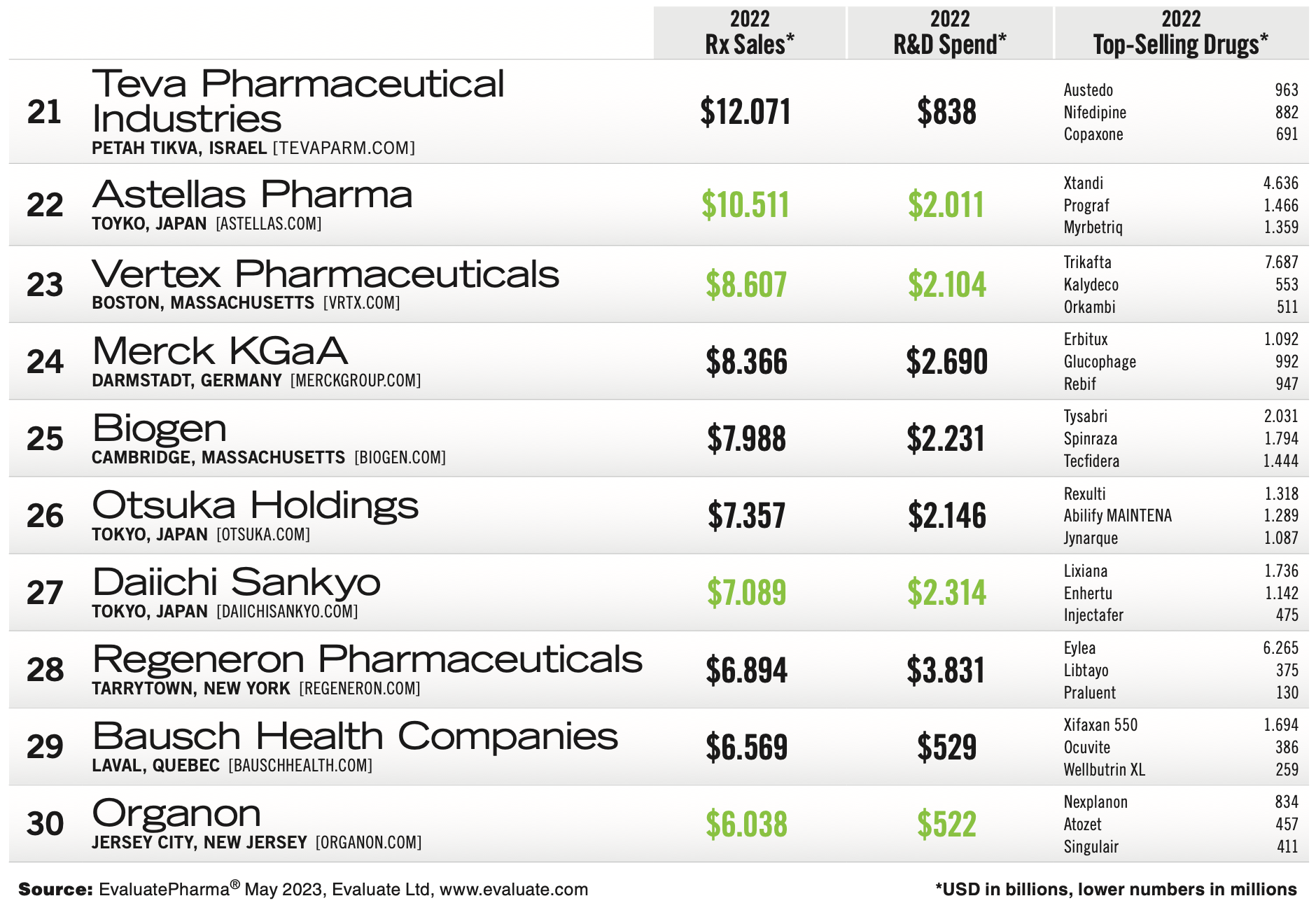
Movers and shakers
As mentioned, Pfizer and AbbVie captured the top two spots again in the Pharma 50—the latter, notably, expected to maintain its solid momentum, even with Humira’s patent expiration this year, thanks to reinforcements Skyrizi for psoriasis (up 75.7% in sales in 2022 to $5.2 billion) and JAK inhibitor Rinvoq (with seven approvals so far, including rheumatoid arthritis and most recently in Crohn’s disease).
Johnson & Johnson (J&J) and Novartis swapped positions from last year’s list to man the third and fourth spots, respectively. J&J prescription drug revenue for 2022 did grow enough to eclipse the $50 billion mark at $50.2 billion. In April, the company announced the overhaul of its infectious disease unit, including cutting its adult RSV vaccine program, HIV, and hepatitis projects. J&J, however, boosted its R&D spending by 20% to $14.1 billion, trailing only Roche, which invested $14.8 billion in its return atop the R&D perch. Novartis reportedly also made trims to its pipeline recently, culling 10% of its assets, including 10 developmental programs in oncology. The company, which is set to spin off its generics division, Sandoz, in the second half of the year, did raise its 2023 full-year sales outlook after reporting a 3% increase in net profit in Q1.
Roche trailed fifth-place Merck in Rx sales, posting a 2.8% drop to $47.9 million. The company’s traditionally strong HER2 cancer franchise is under pressure from rising targeted-drug competitors, such as AstraZeneca and Daiichi Sankyo’s Enhertu, cleared in the US in May 2022 as a second-line therapy in HER2-positive breast cancer, with potential broader use possible. Notably in recent months, Roche has been hit by clinical setbacks to its anti-TIGIT checkpoint inhibitor program and its anti-amyloid antibody candidate for Alzheimer’s. BMS’ Rx output held steady in 2022, placing seventh at $45.4 billion behind $11.8 billion from the company’s blood thinner, Eliquis. Like other Big Pharma, BMS hopes to reap the promise of ADCs as evidenced by its recent development deal struck with Munich-based Tubulius that could end up totaling more than $1 billion.
GSK again claims the 10th spot on our list, with an increase of 14.4% to $38.3 billion, driven by skyrocketing sales of it shingles vaccine, Shingrix (up 56.3% to $3.7 billion). On the RSV front, Evaluate’s Brown believes building the market will be “a slow burner,” as GSK’s Arexvy, Pfizer’s Abrysvo, and potential jabs to follow, including an mRNA candidate from Moderna, will initially deal with complex reimbursement and usual vaccine hesitancy issues.
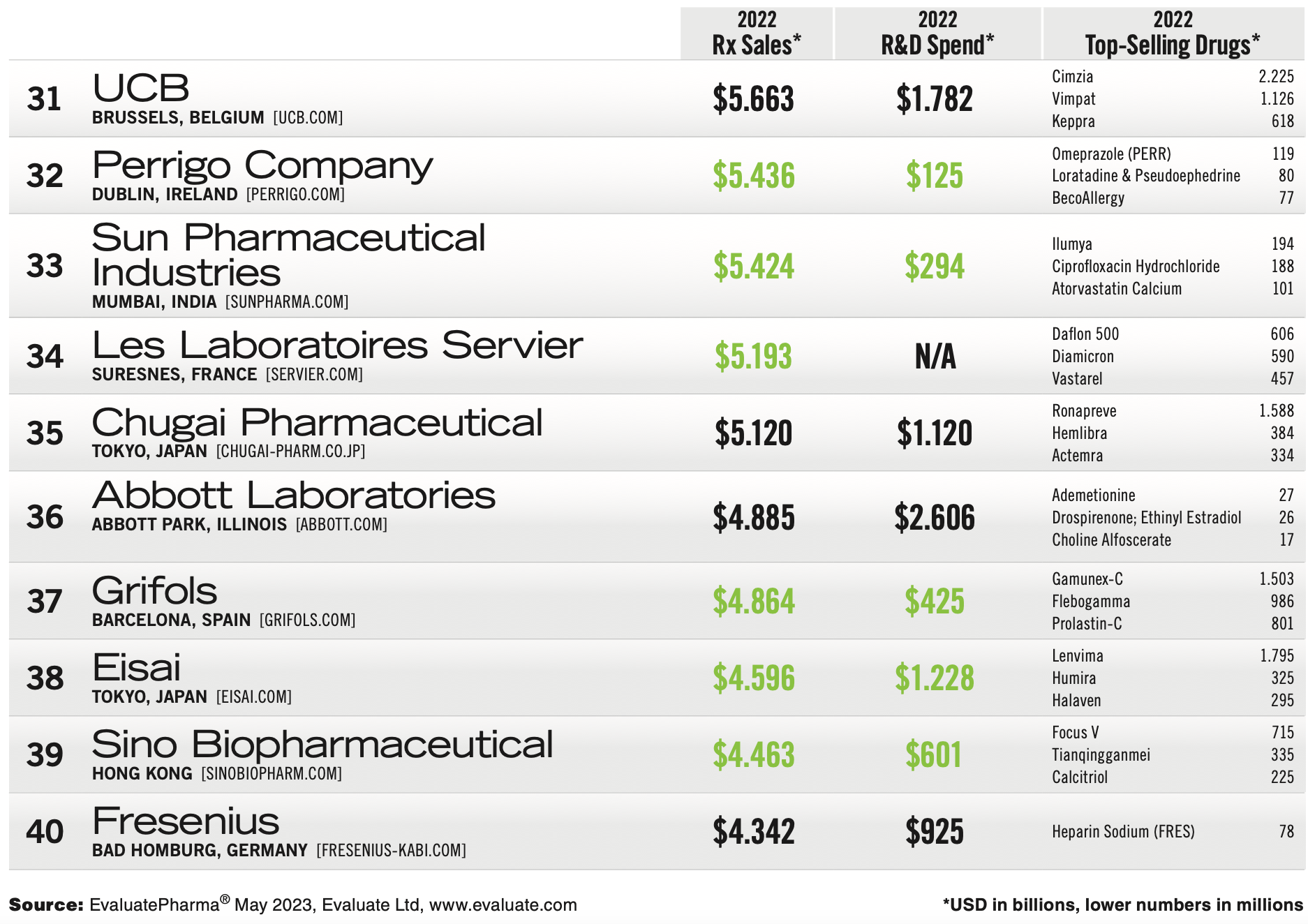
As mentioned, Lilly and Novo Nordisk are two organizations that sit just outside the top 10 but are on track to barge through in due time. Lilly, which as Evaluate points out has the second-largest market cap at the moment behind J&J, has turned heads of late for its commercial potential in two settings in particular. In pivotal Phase III clinical trial results released in May, Lilly’s experimental anti-amyloid antibody, donanemab, slowed mental and physical decline in people with early Alzheimer’s. The company is expected to file donanemab for approval with FDA this month, though excitement at the prospects of accelerated approval and a strong launch will likely be tempered, says Brown, if Medicare doesn’t ease its strict coverage and reimbursement restrictions for new Alzheimer’s drugs (Leqembi, made by Biogen and Eisai, who were ranked 25th and 38th, respectively, on our list, could gain full approval in July).
Lilly’s clear catalyst for growth, however, lies in the diabetes and obesity markets, where its GIP/GLP-1 dual receptor agonist, Mounjaro, approved last year in type 2 diabetes (making just over $1 billion in its first full three quarters), is poised to rival Novo Nordisk’s Wegovy for weight loss once approved in that indication. Evaluate predicts combined sales for Mounjaro of $17 billion in 2028. Those numbers may just be scratching the surface, however.
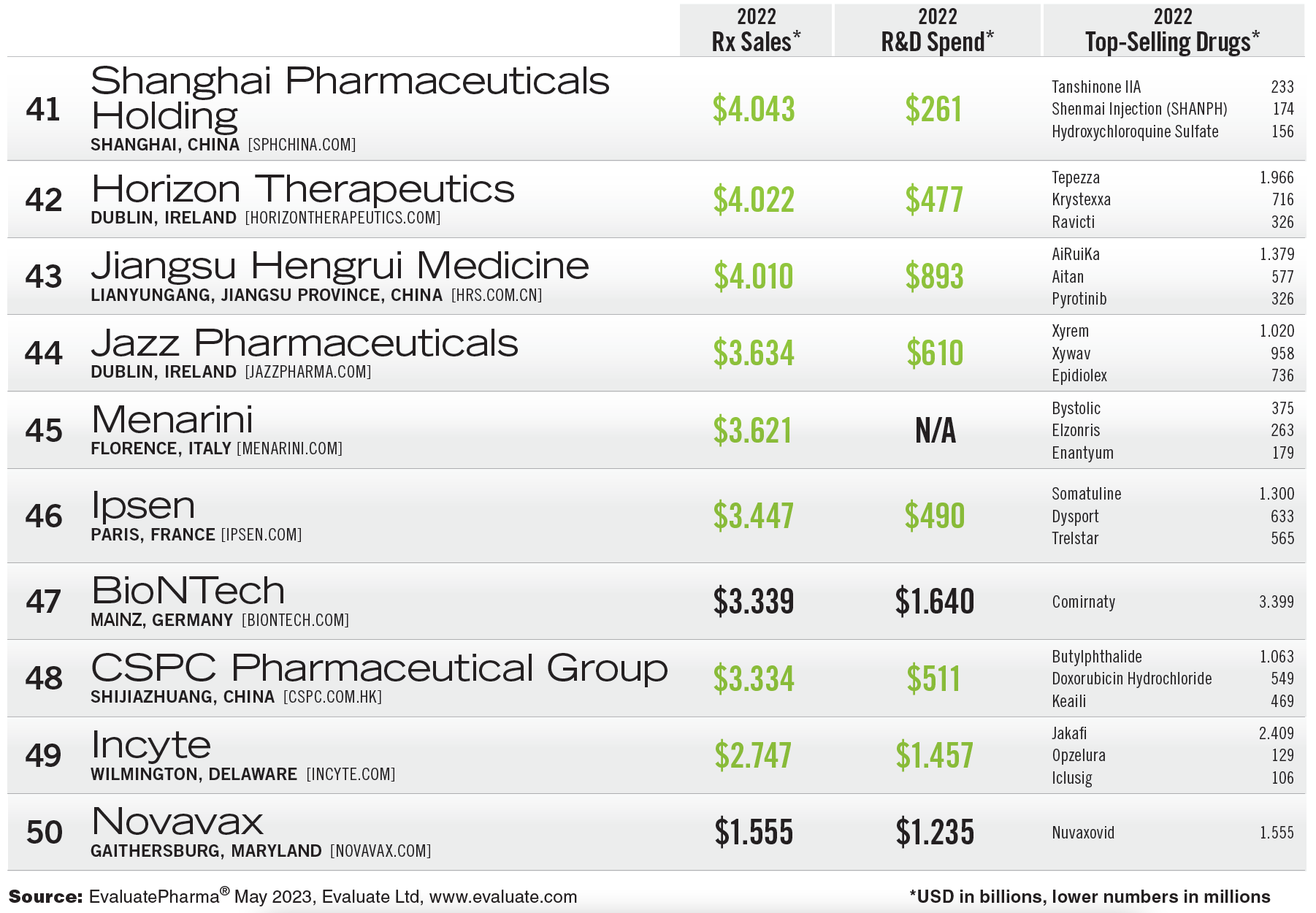
“People are saying that Mounjaro could be the first $100-billion drug,” says Madeleine Armstrong, news editor, Evaluate Vantage, noting its potential in a host of indications. “[Lilly] will become the biggest [pharma company] if that actually really happens.”
Evaluate forecasts total Rx sales for the company of $48 billion in 2028, which would be an 88% jump from its $25.5 billion total in 2022 and the 13th spot on our list. Novo Nordisk finished close behind with prescription drug sales of $25.4 billion, highlighted by a 59.7% spike for Ozempic (smaller-dose Wegovy for diabetes) to $8.6 billion. Evaluate predicts Novo Nordisk, which Armstrong notes has been active in diversifying its therapeutic portfolio, will total $49 billion in prescription drug revenue in 2028, a figure that would place it in the No. 6 spot in this year’s Pharma 50.
Other notable maneuvers in this year's list include Boehringer Ingelheim’s jump two spots, from 18th to 16th, and totaling $19.5 billion in Rx sales behind a nearly doubling for type 2 diabetes drug Jardiance ($6.2 billion); CSL climbing up the ladder to 20th with a 25.7% increase; and Bausch Health Companies surging up five spots, from 34th to 29th, on the strength of 33.4% growth.
Besides BioNTech and Novavax, other new entrants to the Pharma 50 include Perrigo Company at No. 32, Chugai Pharmaceutical at No. 35, and Incyte at No. 49.
Michael Christel is Pharm Exec’s Group Managing Editor. He can be reached at mchristel@mjhlifesciences.com.
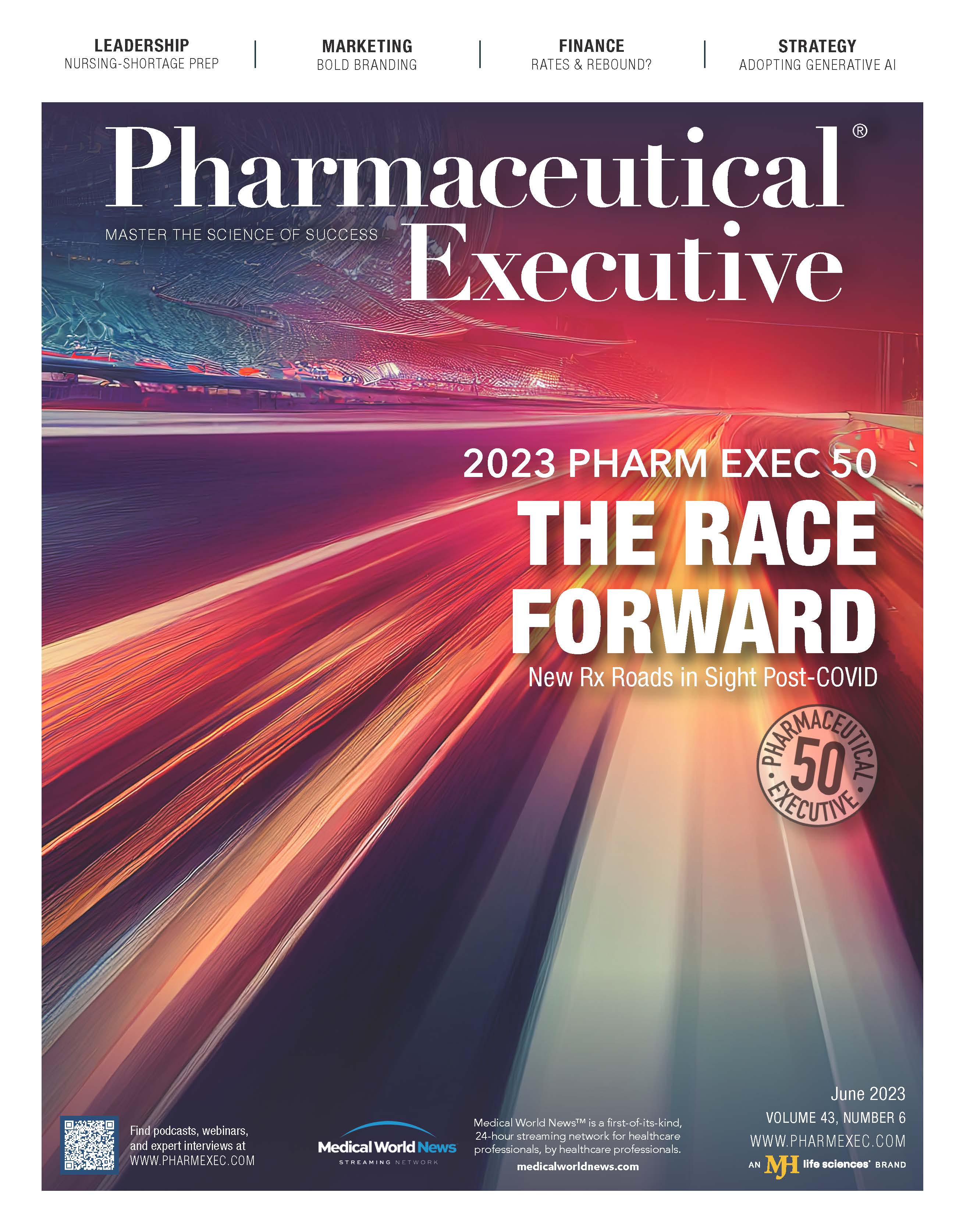
Transforming Cancer Care: Data, AI, and Patient-Centered Care
July 20th 2023Join us as Mohit Manrao, SVP and head of US oncology at AstraZeneca, shares his patient-centered approach to transforming cancer care, bridging the gap between innovative science and tangible patient outcomes across all populations on a global scale.
